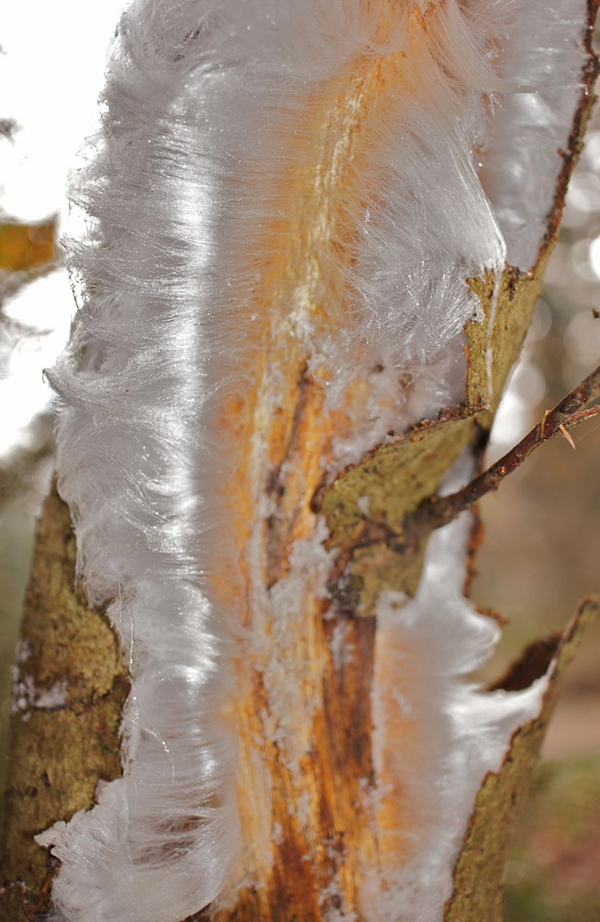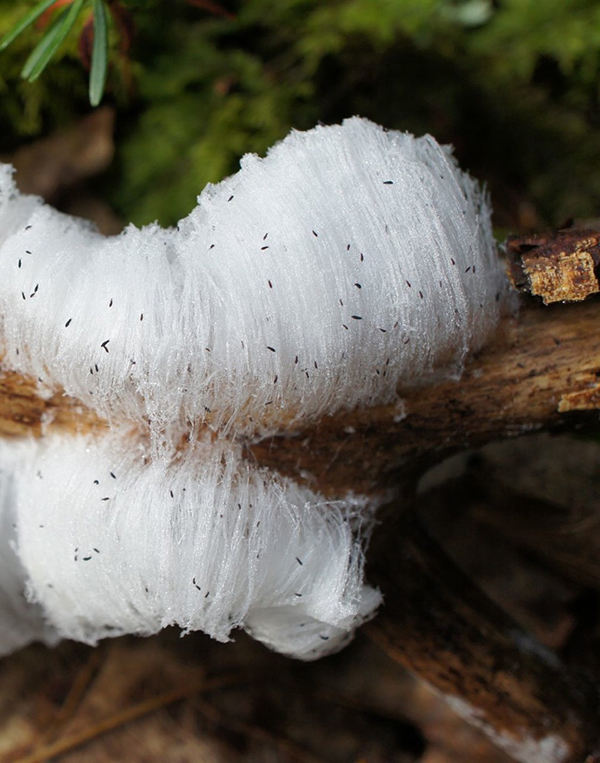
by Catherine Hudson Monday, October 12, 2015

Hair ice is named for its resemblance to tufts of fine silver hair. Its individual strands grow up to 10 centimeters long but are roughly just one one-hundredth of a millimeter thick. Credit: G. Preuss and C. Mätzler
If you have ever taken a morning hike through the woods and seen strange, silky-looking ice on fallen logs, you might have been observing a phenomenon that has puzzled hikers and scientists alike for at least a century. In a new study, researchers examining so-called hair ice have unraveled an explanation for these peculiar formations.
What makes hair ice so obviously different from snow, hail, frost and other forms of ice is its unique shape and the particular range of locations where it’s found. Named for its resemblance to tufts of fine silver hair, hair ice’s individual strands grow up to 10 centimeters long but are roughly just one one-hundredth of a millimeter thick. It is mostly found between 45 and 55 degrees north latitude, and is typically observed on the decaying wood of broad-leaf trees.
Hair ice is difficult to study because it’s a “rare and fleeting phenomenon,” says Diana Hofmann, a researcher at the Institute of Bio- and Geosciences in Germany and lead author of the new study, published in the journal Biogeosciences. “Hair ice grows mostly during the night and melts again when the sun rises. It’s invisible in the snow and inconspicuous in hoarfrost.”
Alfred Wegener, better known for developing the theory of continental drift, published the first known study of hair ice in 1918 after seeing the unusual ice shape in France and Germany. Based on his observation of fungal growths on branches where hair ice formed, he posited but could not confirm that the two were related. Only recently have scientists been able to look more closely at its growth.
In the new study, Hofmann and her colleagues confirmed — almost 100 years after Wegener’s hypothesis — that a specific type of fungus must be present in the wood for hair ice to form. In their experiments, the researchers studied 78 samples of hair-ice-bearing wood collected from forests in Germany; they also examined 41 hair-ice-bearing trees and branches in their natural locations in the forest. Under the microscope, they identified 11 types of fungi on wood that produced hair ice. One in particular, the winter-active fungus, Exidiopsis effusa, was found on every sample.

Researchers think a fungus is responsible for the peculiar shape of hair ice, which grows ephemerally on decaying wood. Credit: G. Preuss and C. Mätzler
To test whether the fungus was necessary for the growth of hair ice, the team applied fungicide to some branches of wood and heat treatments to others. Both treatments hindered growth of the fungus, and, in turn, prevented hair ice from forming, thus confirming that the fungus played a key role. Without the fungus, however, the same amount of ice was still produced; it just formed crusts over the wood instead of thin hairs. That suggested that “only the ice shape is influenced by the fungus,” Hofmann says.
The exact reason for this is not yet clear, Hofmann says, but she and her colleagues determined that a process known as ice segregation was actually responsible for producing the ice at the wood’s surface. In ice segregation, liquid water in pore spaces in the wood is drawn to nucleating ice crystals on the tree surface, causing the nuclei to grow gradually. For its part, Hofmann says that E. effusa breaks down the wood as the fungus grows, consuming part of the plant tissue but leaving complex molecules like lignin and tannin behind. These molecules can then mix into liquid water in the wood pores and direct the shape of ice that subsequently grows from that water, possibly by inhibiting ice hairs from recrystallizing into more stable shapes.
Because the fungus itself only grows at certain latitudes, establishing “that hair ice is related to the fungus … will help explain the geographic distribution of the existence of hair ice,” says James Carter, an ice specialist at Illinois State University who studies peculiar ice forms but was not involved in the new study. “The combined efforts of scientists in complementary disciplines” represented in the new work lend credibility to the team’s findings, Carter says.
Despite the new findings, both Hofmann and Carter say there are more questions to be answered about where hair ice and other mysterious shapes like ice flowers and ice pebbles form, why they only grow on certain tree and plant species, and whether there are other strange ice forms that haven’t been discovered yet. But perhaps it won’t take another 100 years to answer some of them. “People have seen hair ice and similar forms of ice in nature for centuries,” Carter says. “Now that we have the Internet and digital cameras, people are able to share their findings, and we are able to see many examples of these forms of ice.”
© 2008-2021. All rights reserved. Any copying, redistribution or retransmission of any of the contents of this service without the expressed written permission of the American Geosciences Institute is expressly prohibited. Click here for all copyright requests.